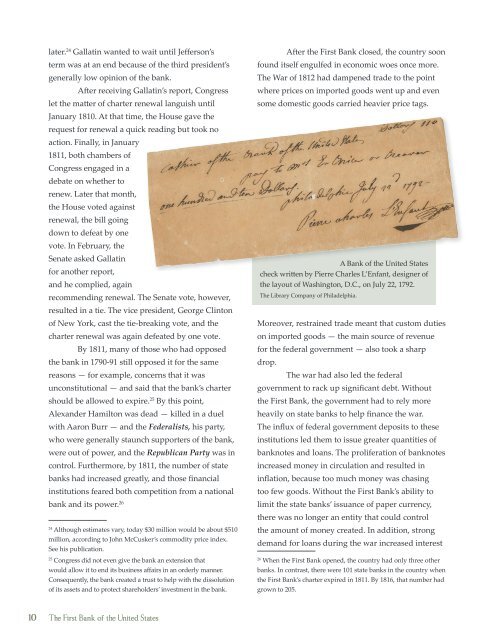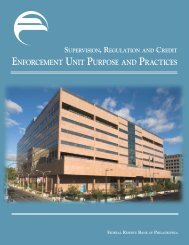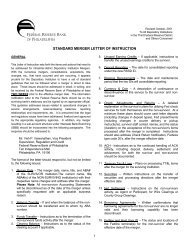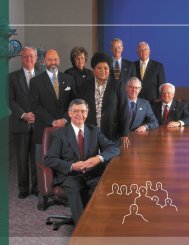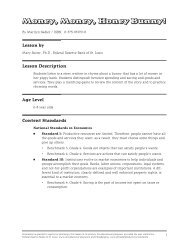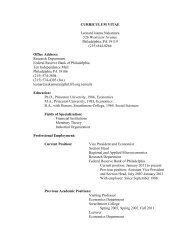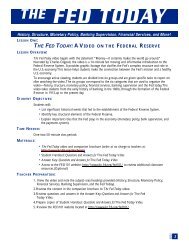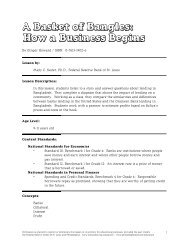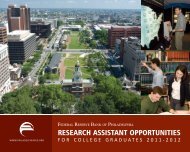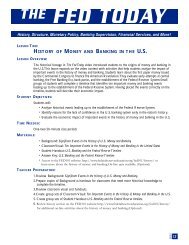The First Bank of the United States - Federal Reserve Bank of ...
The First Bank of the United States - Federal Reserve Bank of ...
The First Bank of the United States - Federal Reserve Bank of ...
You also want an ePaper? Increase the reach of your titles
YUMPU automatically turns print PDFs into web optimized ePapers that Google loves.
10<br />
later. 24 Gallatin wanted to wait until Jefferson’s<br />
term was at an end because <strong>of</strong> <strong>the</strong> third president’s<br />
generally low opinion <strong>of</strong> <strong>the</strong> bank.<br />
After receiving Gallatin’s report, Congress<br />
let <strong>the</strong> matter <strong>of</strong> charter renewal languish until<br />
January 1810. At that time, <strong>the</strong> House gave <strong>the</strong><br />
request for renewal a quick reading but took no<br />
action. Finally, in January<br />
1811, both chambers <strong>of</strong><br />
Congress engaged in a<br />
debate on whe<strong>the</strong>r to<br />
renew. Later that month,<br />
<strong>the</strong> House voted against<br />
renewal, <strong>the</strong> bill going<br />
down to defeat by one<br />
vote. In February, <strong>the</strong><br />
Senate asked Gallatin<br />
for ano<strong>the</strong>r report,<br />
and he complied, again<br />
recommending renewal. <strong>The</strong> Senate vote, however,<br />
resulted in a tie. <strong>The</strong> vice president, George Clinton<br />
<strong>of</strong> New York, cast <strong>the</strong> tie-breaking vote, and <strong>the</strong><br />
charter renewal was again defeated by one vote.<br />
By 1811, many <strong>of</strong> those who had opposed<br />
<strong>the</strong> bank in 1790-91 still opposed it for <strong>the</strong> same<br />
reasons — for example, concerns that it was<br />
unconstitutional — and said that <strong>the</strong> bank’s charter<br />
should be allowed to expire. 25 By this point,<br />
Alexander Hamilton was dead — killed in a duel<br />
with Aaron Burr — and <strong>the</strong> <strong>Federal</strong>ists, his party,<br />
who were generally staunch supporters <strong>of</strong> <strong>the</strong> bank,<br />
were out <strong>of</strong> power, and <strong>the</strong> Republican Party was in<br />
control. Fur<strong>the</strong>rmore, by 1811, <strong>the</strong> number <strong>of</strong> state<br />
banks had increased greatly, and those financial<br />
institutions feared both competition from a national<br />
bank and its power. 26<br />
24 Although estimates vary, today $30 million would be about $510<br />
million, according to John McCusker’s commodity price index.<br />
See his publication.<br />
25 Congress did not even give <strong>the</strong> bank an extension that<br />
would allow it to end its business affairs in an orderly manner.<br />
Consequently, <strong>the</strong> bank created a trust to help with <strong>the</strong> dissolution<br />
<strong>of</strong> its assets and to protect shareholders’ investment in <strong>the</strong> bank.<br />
<strong>The</strong> <strong>First</strong> <strong>Bank</strong> <strong>of</strong> <strong>the</strong> <strong>United</strong> <strong>States</strong><br />
After <strong>the</strong> <strong>First</strong> <strong>Bank</strong> closed, <strong>the</strong> country soon<br />
found itself engulfed in economic woes once more.<br />
<strong>The</strong> War <strong>of</strong> 1812 had dampened trade to <strong>the</strong> point<br />
where prices on imported goods went up and even<br />
some domestic goods carried heavier price tags.<br />
A <strong>Bank</strong> <strong>of</strong> <strong>the</strong> <strong>United</strong> <strong>States</strong><br />
check written by Pierre Charles L’Enfant, designer <strong>of</strong><br />
<strong>the</strong> layout <strong>of</strong> Washington, D.C., on July 22, 1792.<br />
<strong>The</strong> Library Company <strong>of</strong> Philadelphia.<br />
Moreover, restrained trade meant that custom duties<br />
on imported goods — <strong>the</strong> main source <strong>of</strong> revenue<br />
for <strong>the</strong> federal government — also took a sharp<br />
drop.<br />
<strong>The</strong> war had also led <strong>the</strong> federal<br />
government to rack up significant debt. Without<br />
<strong>the</strong> <strong>First</strong> <strong>Bank</strong>, <strong>the</strong> government had to rely more<br />
heavily on state banks to help finance <strong>the</strong> war.<br />
<strong>The</strong> influx <strong>of</strong> federal government deposits to <strong>the</strong>se<br />
institutions led <strong>the</strong>m to issue greater quantities <strong>of</strong><br />
banknotes and loans. <strong>The</strong> proliferation <strong>of</strong> banknotes<br />
increased money in circulation and resulted in<br />
inflation, because too much money was chasing<br />
too few goods. Without <strong>the</strong> <strong>First</strong> <strong>Bank</strong>’s ability to<br />
limit <strong>the</strong> state banks’ issuance <strong>of</strong> paper currency,<br />
<strong>the</strong>re was no longer an entity that could control<br />
<strong>the</strong> amount <strong>of</strong> money created. In addition, strong<br />
demand for loans during <strong>the</strong> war increased interest<br />
26 When <strong>the</strong> <strong>First</strong> <strong>Bank</strong> opened, <strong>the</strong> country had only three o<strong>the</strong>r<br />
banks. In contrast, <strong>the</strong>re were 101 state banks in <strong>the</strong> country when<br />
<strong>the</strong> <strong>First</strong> <strong>Bank</strong>’s charter expired in 1811. By 1816, that number had<br />
grown to 205.


